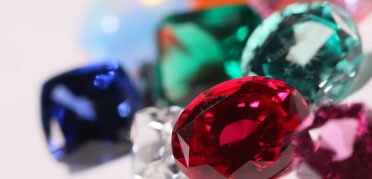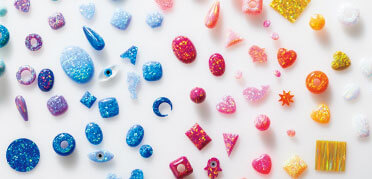Jewelry Glossary
-
B
-
Baby Ring
Baby ring is given with wishes that the baby will grow up healthy. It is given from grandparents or parents to their children in commemoration of the birth. Baby rings are made to fit a baby's finger, so the size is extremely small. Some people use a baby ring as a pendant head.
-
Baguette Cut
The baguette cut is a rectangular step cut.
Many gems cut this way are small in size because the risk of chipping the corners increases with size. To minimize the risk of chipping, most large gemstones are cut into emerald cuts which have more resiliant corners.
The square step cut is called "Karee" and it is used for band rings which gemstones are set over the entire circumference of the ring. -
Bail
The bail of necklace is a part that connects the chain and the pendant top. It supports the pendant top to face forward when wearing a necklace.
-
Ball Bracelet
Ball bracelets are composed of spherical gemstones or metals. Pearls as well as other materials like turquoise and crystal can also be used.
-
Ball Chain
A ball chain is a chain with ball-shaped parts. This chain is made by rounding a thin plate into a cylindrical shape and cutting it while squeezing it into a spherical shape, then connecting the wire material (spherical) into the ball. The ball with a cut facet is called a "cut ball."
-
Bangle
The bangle is a circular type of bracelet with no fasteners. It is relatively more voluminous than other typical bracelets.
There are various shapes of bangles, such as circle, oblong, C-shaped, horseshoe shaped, square, and octagonal shaped. -
Bead Setting
The bead setting is to make a small prong by curving the surface of the metal and fixing melee size gemstones.
Care must be taken in case moh's hardness of setting gemstones is less than 7 and should be avoided setting the gemstones whose moh's hardness is less than 4. -
Belcher Setting
Belcher setting is one of the techniques of bead setting.
U-shaped curves, which are a bit bigger than a gemstone, separate the prongs and make a petal-like design. -
Benitoite
Benitoite was initially considered sapphire when first founded in San Benito Mine, California, in 1907. It is mostly blue, but colorless and pink are also produced. Due to the strong dispersion and dichroism, the blue cut one seems colorless depending on the direction you look from.
[Moh's hardness: 6] [Mineral species: Benitoite] -
Beryl
Beryl, represented by emeralds and aquamarines, has been used as a gem since ancient times. Around 1925, many applications of Beryllium, which is a major element of beryl, were discovered and since then it has become widely explored as a resource mineral. Beryl was named after "beryllos" which means green stones in Greek. The elements which give beryl its green hue are trace amounts of chromium and vanadium, and the light blue of aquamarine is due to trace amounts of iron.
-
Bezel Setting
A bezel setting is a general term used for setting styles. Channel setting and rim setting are categorized as this setting, and the gemstone is surrounded by metal.
-
Bib Necklace
Please refer to "shower necklace."
-
Bi-colored Tourmaline
Bi-colored tourmaline is a mysterious looking gem which displays two colors such as pink and green or pink and blue in a single crystal. It is often polished to a step cut to enhance the combination of colors. The color combination is unique to each stone therefore subjective taste plays an important part in judging these stones. Market value is determined based on color balance such as pink and pale green, pink and blue.
[Moh's hardness: 7] [Mineral species: Tourmaline] -
Birth Stone Ring
Birth stone ring is a ring with a birthstone, and it is believed that the ring will avoid misfortune and bring happiness. The habit to wear birthstones has begun among Jews around the 18th century.


- Birth Stone Ring -

-
Black Opal
The body color of black opal is black or gray, and it is semitransparent or opaque.
[Moh's hardness: 5] [Mineral species: Opal]
Please click
here
to see the details of Kyocera's Crescent Vert black opal.

White & Black Opal

White and black opal elicit a mysterious charm with their rich interplay of color. Engineered opal captures the essence of that beauty in shades of blue, green, red and purple swirled together in a dazzling display. Our engineered opals shine brightly, with each color expressing a different personal nuance. Opal’s colors result from light reflected through the stone’s silicon dioxide particles.
Kyocera’s proprietary process creates what nature cannot: Uniformly thick opal stones that won’t split or chip, making them ideal for intricate jewelry designs. Unlike natural opal, Crescent Vert opal and black opal can be easily and precisely cut, achieving what was once impossible in the jewelry world. In addition, Crescent Vert opal is incredibly durable, offering high heat resistance because of its well-balanced internal water content.Available in sizes up to 15 carats.* If you need a larger stone, please contact us.View Comparison Table White Opal Black Opal Item Crescent Vert Opal Natural Opal Crescent Vert Opal Natural Opal Chemical Composition SiO2・nH2O SiO2・nH2O SiO2・nH2O SiO2・nH2O X-ray Diffraction Amorphous Amorphous Amorphous Amorphous Spectroscopic Analysis Same as natural stone Specific absorption of Opal Same as natural stone Specific absorption of Black Opal Crystal system Amorphous Amorphous Amorphous Amorphous Mohs Hardness 5.0~6.5 5.5~6.5 5.0~6.5 5.5~6.5 Specific Gravity 1.90~2.23 1.90~2.20 1.95~2.20 1.98~2.20 Transparency Transparent ~ Translucent Transparent ~ Translucent Translucent ~ Opaque Translucent ~ Opaque Refractive Index 1.440~1.465 1.440~1.465 1.440~1.465 1.435~1.455 Ultraviolet Ray Examination (Long Wavelength)
Dark bluish violet - Inert
(Short Wavelength)
Pale blue - Inert(Long Wavelength)
Strong bluish white - Inert
(Short Wavelength)
Pale blue - Inert(Long Wavelength)
Dark bluish violet - Inert
(Short Wavelength)
Pale blue - Inert(Long Wavelength)
Strong bluish white - Inert
(Short Wavelength)
Pale bluish white - InertSpecial Effect Play of color Play of color Play of color Play of color -
Block Chain
Block chain is a continuous connection of precious metal plates or rods, etc. The snake chain and ball chain fall into this category.
-
Bloodstone
Bloodstone is also called heliotrope. It is deep green chalcedony with spots of red jasper.
The spots look like drops of blood.
In medieval Europe, it was believed that the gem prevented nosebleed, that it would calm anger, and was a remedy for inflammatory diseases.
[Moh's hardness: 6] [Mineral species: Chalcedony] -
Blue Chalcedony
In a narrow sense, chalcedony refers to a bluish white gray species similar to blue chalcedony. The most transparent and beautiful stones are not currently produced, dyed ones are sometimes available at the market.
[Moh's hardness: 6] [Mineral species: Chalcedony] -
Blue Diamond
The colors of prized blue diamonds are thanks to the presence of trace amounts of Boron.
It mainly originates from the premier mines in South Africa where only a small amount is produced. Stones that do not contain grayish hues are more sought after. Due to the small absolute quantity produced, it is very difficult to find superior quality pieces.
There are also diamonds on the market that are of poor quality, treated at high temperatures and pressures, and irradiated to turn them blue.
[Moh's hardness: 10] [Mineral species: Diamond] -
Blue Topaz
Currently, 99% of blue topaz in the market is artificially colored by irradiating colorless topaz. This treatment for blue topaz became popular in 1980s soon after the market was flooded with blue topaz. Colorless topaz is produced in large amounts, so radiation expenses and polishing cost makes up a substantial portion of the cost.
[Moh's hardness: 8] [Mineral species: Topaz] -
Brilliancy
Brilliancy is a sparkle of brilliant cut and step cut gemstones. Furthermore, it is a visible white light seen by refraction and reflection.
-
Brilliant Cut
Brilliant cut is based on tolkowsky proportions, and polished to a total of 58 surfaces. It maximizes the brilliance of a diamond and fire considering optical properties such as refraction and reflection.
-
Briolette Cut
The briolette cut is a drop-shaped cut with a triangular or rectangular surface. When it sways, it shows a unique brilliance reminiscent of a mirror ball. Normally, it has a hole at the tip and is connected in series to make a necklace or hung to make earrings.
It is difficult to find a rough stone that can be cut into briolette because a long rounded and highly transparent rough stone is needed for this cut. -
Brooch
A brooch is a type of jewelry typically worn around the chest area, but can also be used for wrap-around skirts and scarf pins. Brooches are relatively large compared to other types of jewelry. This unique characteristic allows the designer to fully demonstrate their originality.
-
Bruting
Cutting a diamond by hand to give the diamond its shape is called bruting.
-




